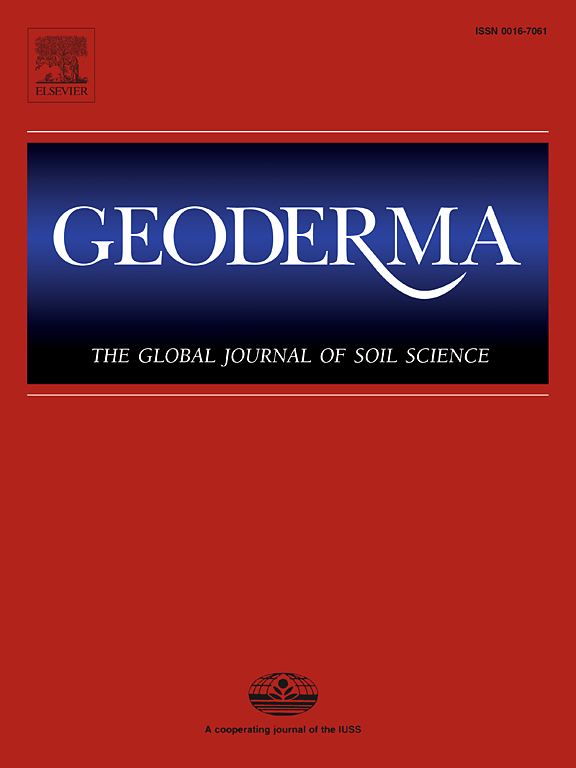在大团聚体中,团聚体孔隙和形状特性与土壤有机碳的相关性更强:来自长期管理诱导的土壤碳梯度的证据
IF 5.6
1区 农林科学
Q1 SOIL SCIENCE
引用次数: 0
摘要
土壤结构与土壤有机碳(SOC)之间的相互作用是复杂的,影响着土壤的关键功能。关于这种关系如何随所研究的结构单元的大小而变化的知识有限。本研究的目的是量化不同土壤管理制度下不同粒径土壤团聚体的孔隙和形态特征及其与有机碳的关系。2015年3月,洛桑研究所的海菲尔德·利-阿拉布尔长期实验对土壤进行了采样。试验包括裸休、连续耕地轮作、耕地轮作和草地处理。采用40 μm体素分辨率的x射线微ct扫描,对每种处理和尺寸类别(2-4、4-8和8-16 mm)共24个聚集体进行扫描。结果表明,与裸休耕相比,永久草不仅增加了土壤有机碳的积累,而且提高了土壤团聚体的孔隙连通性,无论团聚体大小如何。此外,粒径较大的团聚体(4 ~ 8 mm和8 ~ 16 mm)的孔隙和形状特征比粒径较小的团聚体(2 ~ 4 mm)对土壤管理更为敏感。8-16和4-8 mm团聚体的有机碳含量与团聚体结构特征的关系较强,而2-4 mm团聚体的有机碳含量与团聚体结构特征的关系较弱。孔隙连通性和球形度对有机碳的响应随骨料粒径的增大而增大。研究结果表明,有机质输入在形成团聚体结构特征和团聚体重排(特别是在较大团聚体中)中起着重要作用。本文章由计算机程序翻译,如有差异,请以英文原文为准。
Aggregate pore and shape properties were more strongly correlated to soil organic carbon in large aggregates: Evidence from a long-term management-induced soil carbon gradient
The interplay between soil structure and soil organic carbon (SOC) is complex and affects key soil functions. There is limited knowledge on how this relationship changes with the size of the structural unit studied. The objective of this study was to quantify the pore and shape characteristics of soil aggregates of varying sizes, and their relationships with SOC under different soil management regimes. Soils were sampled in March 2015 from the Highfield Ley-Arable Long-Term Experiment at Rothamsted Research. This experiment includes bare fallow, continuous arable rotation, ley-arable rotation, and grass treatments. A total of 24 aggregates from each treatment and size class (2–4, 4–8, and 8–16 mm) were subjected to X-ray micro-CT scanning at 40 μm voxel resolution. Results showed that permanent grass not only increased SOC accumulation, but also promoted pore connectivity of soil aggregates compared to bare fallow, regardless of aggregate size. Additionally, the pore and shape characteristics of larger aggregates (4–8 and 8–16 mm) were more sensitive to soil management compared to smaller aggregates (2–4 mm). The relationships between SOC and aggregate structural characteristics were strong for both 8–16 and 4–8 mm aggregates but weak for 2–4 mm aggregates. Furthermore, the responses of pore connectivity and sphericity to SOC increased with aggregate size. The results suggest that organic matter input plays an essential role in shaping aggregate structural characteristics and aggregate rearrangement (especially in larger aggregates).
求助全文
通过发布文献求助,成功后即可免费获取论文全文。
去求助
来源期刊

Geoderma
农林科学-土壤科学
CiteScore
11.80
自引率
6.60%
发文量
597
审稿时长
58 days
期刊介绍:
Geoderma - the global journal of soil science - welcomes authors, readers and soil research from all parts of the world, encourages worldwide soil studies, and embraces all aspects of soil science and its associated pedagogy. The journal particularly welcomes interdisciplinary work focusing on dynamic soil processes and functions across space and time.
 求助内容:
求助内容: 应助结果提醒方式:
应助结果提醒方式:


